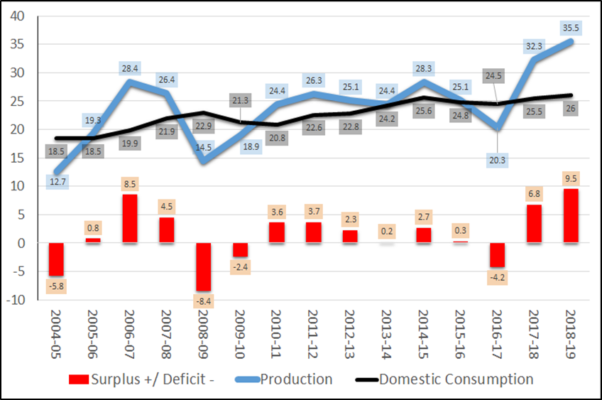- Home
- Prelims
- Mains
- Current Affairs
- Study Materials
- Test Series
 Latest News
Latest News
India's sugar exports accelerate on rising global prices
As surging global prices and a weak rupee have made overseas sales of sugar lucrative, Indian sugar mills have signed contracts to export 550,000 tonnes of the sweetener in recent days.
Increased Sugar exports from India


The Ethanol Option
- Higher exports from the world's second-biggest sugar producer could check the rally in global prices , which have been buoyed by a spike in crude oil prices and lower output in top exporter Brazil.
- The shipments would also help India reduce its stockpile and support the local prices of the sweetener, crucial in ensuring millions of cane farmers get government-mandated prices.
- The depreciation of the rupee has increased the margin of traders from overseas sales.
- The significance of sugarcane and sugar industry for India’s economy can be gauged from the fact that it is a country’s second largest Agro-based industry next to cotton.
- It impacts the livelihood of over five crore farmers and their dependents. India is the largest consumer and second largest producer of sugar in the world.
- The average annual production of sugarcane is about 3.35 crore tonnes which is used to procure about 3 crore tonnes of sugar.The domestic consumption is estimated to be around 2.6 crore tonnes in 2020-21.
- India has become a sugar surplus nation over the years as reflected from the trend of sugar production and consumption. Since 2010-11, the production of outstripped consumption except in 2016-17.

- The surplus production has been possible because of various measures undertaken by the government, for instance the interest of farmers is protected by fair and remunerative price (FRP) which has doubled in a span of 10 years.
- In addition, some state governments announce State advice prices (SAP) at levels higher than FRP.
- Additionally, sugar mills that buy sugarcane are mandated to purchase crops from farmers within a specific radius known as Cane reservation area. In this way, sugarcane farmers are insured and protected against price risk.

- The government has also taken various steps to handle the surplus production and enhance liquidity of mills like incentivising sugar mills to divert excess sugar cane/sugar to ethanol production, providing financial assistance for transfer to sugar mills to facilitate export of sugar etc.
- In the past four sugar seasons till 2020-21, revenue of about Rs.35,000 crore has been generated by sugar mills from sale of ethanol to oil marketing companies which has helped in clearing cane price arrears of farmers.
- The Cabinet committee on economic affairs has approved the FRP of sugarcane at Rs.290 per quintal for 2021-22 marketing year.
- FRP is the minimum price that mills have to pay to the sugar cane producers.
- The concept of statutory minimum price (SMP) of sugar cane was replaced with fair and remunerative price (FRP) with the amendment of Sugarcane (control) order, 1966 in 2009.
- The cane price announced by the union government is decided on the basis of recommendations of commission for agricultural costs and prices (CACP) in consultation with the state government after taking feedback from associations of the sugar industry and cane growers.
The amended provisions of the Sugarcane (Control) Order, 1966 provides for fixation of FRP of sugarcane having regard to the following factors:
|
- India’s ethanol programme i.e blending ethanol with petrol for use as auto fuel, was first announced in 2003.
- It did not take up for various reasons like poor pricing of ethanol supplied for blending, periodic shortages of sugar and competing demand from potable alcohol sector.
- The government revived the programme and gave necessary impetus by fixing attractive prices for ethanol that oil marketing companies procure for blending motivating sugar mills to produce ethanol.
- The government also allowed sugar mills to produce ethanol from earlier stages of sugar production rather than just C-Molasses.
- As a first step it allowed conversion of B-heavy molasses (which has more sugar content than C-Molasses and is typically converted into sugar) and then followed it up by allowing mills to produce ethanol directly from sugarcane juice.
- Target of 5% was made in FY21, it is expected to reach 8% in FY 22 and the aim is to achieve 20% blending by 2025.
- The Rangarajan committee has suggested a formula to fix cane price factoring in the price of sugar and other byproducts.
- According to this formula, a sugar unit without any by-products' business would have to pay cane price of 70% of its revenue realization, while it will have to spend 30% on its functioning. On the other hand, a sugar factory with a by-products business will have to pay cane price of 75% of its revenue realization.
- In case the cane price, arrived by formula, drops below what the government considers as a reasonable payment, it can bridge the gap from a dedicated fund created for the purpose and a cess can be levied to build up the fund.
- The Commission for Agricultural Costs and Prices (CACP) has recommended the government to frame a dual price policy for sugar trade in India with a reasonable price for kitchen consumers and high prices for industrial users depending upon the cost of production and availability.










 General Studies
General Studies